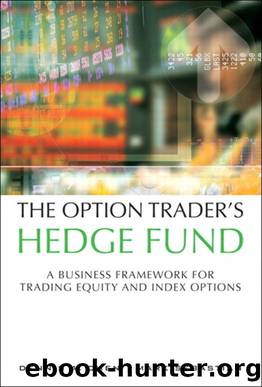The Option Trader's Hedge Fund: A Business Framework for Trading Equity and Index Options by Dennis A. Chen & Mark Sebastian

Author:Dennis A. Chen & Mark Sebastian [Chen, Dennis A.]
Language: eng
Format: mobi
Publisher: Pearson Education
Published: 2012-05-17T23:00:00+00:00
Here are the situations in which to use the different vertical spreads:
Bullish
(1) Vertical call debit spread: Use when partially bullish and donât mind theta decay.
(3) Vertical put credit spread: Use when partially bullish and want positive theta.
Bearish
(2) Vertical put debit spread: Use when partially bearish and donât mind theta decay.
(4) Vertical call credit spread: Use when partially bearish and want positive theta.
Focus on the credit spreads: the vertical put credit spread (bullish) and the vertical call credit spread (bearish). These spreads are theta positive. Assuming that there is no movement in the underlying, the trade earns money as time goes on.
Conditions
The vertical spread is best when you have an opinion on the direction of the market.
Volatility rule: Use vertical credit spreads in times of stable or declining market volatility. The width of the spread depends on the steepness of the skew. In steep curves, narrower spreads are recommended so the long option volatility has less of a gap with respect to the volatility of the short option. If the skew is less steep, you may use wider spreads to save on commissions.
Time: Usually place vertical spread trades with 30 to 60 days to expiration. This depends on how far out-of-the-money the spread is placed. On far OTM spreads the theta decay is more linear, so when youâre doing longer trades, as in an iron condor, starting a trade 30 to 60 days from expiration is optimal.
Vertical Spread Example
Here is a vertical put credit spread on AAPL (Apple). On October 13, 2011, 30-day implied volatility and 10-day historical volatility were 38 and 37. IV was greater than HV, which is within normal parameters for this trade. Next, check IV, which was trending down from 51 on October 4, 2011. A falling IV is a good environment for this vertical spread.
You placed the vertical spread on October 13, 2011, at 10 a.m., when AAPL was trading at $405, shorted 10 AAPL NOV 360, and bought the 10 AAPL NOV 350 for a credit of 1.55 per spread, net $1,550 for the trade. See Figure 9.2 for the details. The risk profile of the trade can be seen in Figure 9.1.
Download
This site does not store any files on its server. We only index and link to content provided by other sites. Please contact the content providers to delete copyright contents if any and email us, we'll remove relevant links or contents immediately.
| Analysis & Strategy | Bonds |
| Commodities | Derivatives |
| Futures | Introduction |
| Mutual Funds | Online Trading |
| Options | Portfolio Management |
| Real Estate | Stocks |
Rich Dad Poor Dad by Robert T. Kiyosaki(6399)
Pioneering Portfolio Management by David F. Swensen(6226)
How To Win Friends and Influence People by Dale Carnegie(4441)
The Money Culture by Michael Lewis(4074)
The Dhandho Investor by Mohnish Pabrai(3698)
The Wisdom of Finance by Mihir Desai(3650)
Liar's Poker by Michael Lewis(3367)
Fooled by Randomness: The Hidden Role of Chance in Life and in the Markets by Nassim Nicholas Taleb(3043)
The ONE Thing by Gary Keller(3007)
The Intelligent Investor by Benjamin Graham Jason Zweig(2995)
Mastering Bitcoin: Programming the Open Blockchain by Andreas M. Antonopoulos(2980)
How to Day Trade for a Living: Tools, Tactics, Money Management, Discipline and Trading Psychology by Andrew Aziz(2909)
Rich Dad Poor Dad: What The Rich Teach Their Kids About Money - That The Poor And Middle Class Do Not! by Robert T. Kiyosaki(2907)
Investing For Dummies by Eric Tyson(2893)
How to Win Friends and Influence People by Dale Carnegie(2860)
Market Wizards by Jack D. Schwager(2643)
Zero Hour by Harry S. Dent Jr. & Andrew Pancholi(2614)
How to Pay Zero Taxes, 2018 by Jeff A. Schnepper(2591)
The Psychology of Money by Morgan Housel(2591)
